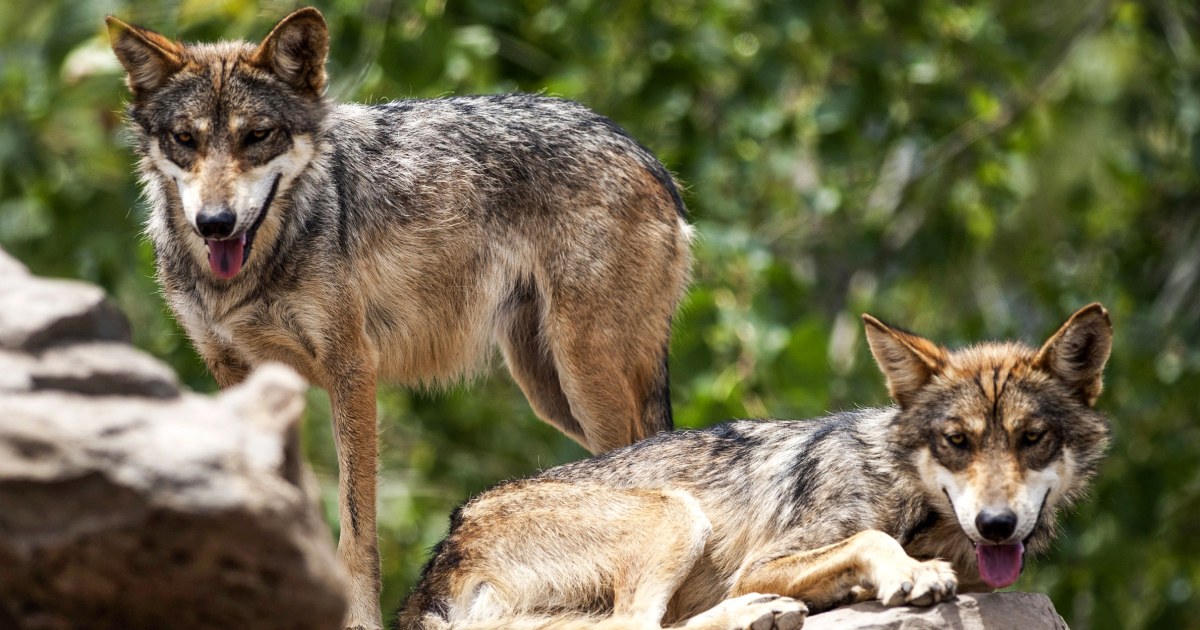
One chilly early morning in November, a wolf roamed southwest of Las Cruces, New Mexico, on the southern border of the U.S. He was probably driven by the call for survival and wanted to mate, researchers say.
In his search for a mate or for better opportunities, the wolf tried to cross the dangerous Chihuahuan Desert, a region he knows very well because it has been his species’ habitat since time immemorial.
This time, however, he was unable to cross. The barriers that make up the border wall prevented him from crossing the border into Mexico.
“For five days he walked from one place to another. It was at least 23 miles of real distance, but as he came and went, he undoubtedly traveled much more than that,” said Michael Robinson, the director of the Center for Biological Diversity, a nonprofit organization that defends and monitors species that are in danger of extinction — like this Mexican gray wolf, whom they called Mr. Goodbar.
Robinson lives in Silver City, very close to Gila National Forest. He noticed the wolf’s adventures when he was reviewing a map from the U.S. Fish and Wildlife Service that records the locations of the wolves using GPS devices they have on necklaces. It is the first time researchers have directly observed how the border wall hinders the life of the species, which is at risk of extinction.
“Mr. Goodbar’s Thanksgiving was forlorn, since he was thwarted in romancing a female and hunting together for deer and jackrabbits,” Robinson said. “But beyond one animal’s frustrations, the wall separates wolves in the Southwest from those in Mexico and exacerbates inbreeding in both populations.”
The dangers of the wall
The Center for Biological Diversity and other organizations have said the border wall cuts off connections for wildlife in the area. The center has filed multiple lawsuits to stop the construction of barriers between the two countries and protect the populations of gray wolves and other endangered animals.
The organization announced Dec. 21 that it plans to sue the Department of Homeland Security and Customs and Border Protection for failing to protect ocelots and other species during the construction of border levees along the Rio Grande Valley in Texas.
“It is hypocritical to use safety as an excuse to repair levees and then ignore federal laws that protect people and wildlife. These alleged repairs are seen more as an excuse to rush the construction of the border wall,” Paulo Lopes, a lawyer for the Center for Biological Diversity, said in a statement.
The organization said more than 13 miles of levees will be built on the land of the Lower Rio Grande Valley National Wildlife Refuge, traversing family farms and other private property in Hidalgo County, Texas.
Ocelots have been in danger of extinction since 1982, and according to official data, it’s estimated that fewer than 50 of them remain in the U.S., all in South Texas.
Restoring their habitat, including creating wildlife corridors, is a priority for the Rio Grande Wildlife Refuge, but the levees project — which involves removing vegetation along the river to build a control zone 150 feet wide with new roads for law enforcement agencies, as well as lighting systems, cameras and sensors — threatens the ocelot’s habitat.
Building a wall on the border between Mexico and the U.S. was one of former President Donald Trump’s main campaign promises, and 450 miles of the project were completed during his presidency. The Biden administration suspended construction work, but Texas’ Republican governor, Greg Abbott, began construction of his own wall on Dec. 20.
“President Biden should knock down the wall,” Robinson said. “Allowing Mexican gray wolves to roam freely would do right by the sublime Chihuahuan Desert and its lush sky-island mountains. We can’t allow this stark monument to stupidity to slowly strangle a vast ecosystem.”
Challenges to survival
By March, the Fish and Wildlife Service had estimated that 186 specimens of the Mexican gray wolf (Canis lupus baileyi) were in the wild, an increase of 14 percent over 2020. The population has increased for five consecutive years. Only 35 of the wolves are in Mexican territory, according to Mexican government data.
In some ways, the fight to preserve the wolves is a success story, because, from 1915 to 1972, U.S. authorities poisoned and trapped almost all of the wolves in the wild. Three of the last five surviving wolves, captured from 1977 to 1980, were bred in captivity along with the progeny of four previously captured Mexican wolves.
Because of a lawsuit filed by the center, the descendants of those seven wolves were reintroduced in the Southwestern U.S. in 1998. On the Mexican side, the wolves’ release began in 2011.
The subspecies is about 5 feet long, usually weighs 50 to 80 pounds and lives in herds of four to nine. Their gray and rust-color fur is abundant. They live from two to eight years, and, despite protective measures, very few die of natural causes.
Historically, their habitat has been the border: They used to live throughout southwestern Texas, southern New Mexico and southeastern Arizona and as far south as central Mexico. Today they are found only in the Gila ecosystem, in eastern Arizona and western New Mexico, and in the Sierra de San Luis, in northern Mexico.
Despite the modest but constant growth of its population, activists and experts have made multiple calls to maintain the protections for the species. Mr. Goodbar, who was born at the Sedgwick County Zoo in Kansas and was released in the desert area of Arizona in 2020, is the result of such measures.
The wolf’s adventurous and exploratory spirit is part of the species’ most basic instincts. It also runs in the family.
Wolves from Mexico twice entered the U.S. at the beginning of 2017. One crossed through the point where Mr. Goodbar couldn’t make it and then returned to Mexico. Two months later, a female crossed into Arizona, and authorities captured her to appease complaints from people linked to the livestock industry.
She is Mr. Goodbar’s mother, and she is still in captivity.
“If the barriers remain on the border, and more are being built, that is going to have an impact on the genetic diversity of the wolves, because it could affect their reproduction. If the wall could be knocked down, at least in some key areas, it has to be done. That will allow for wildlife connectivity,” Robinson said.
A problem of borders
Researchers at the Center for Biological Diversity say wolves aren’t the only species threatened by the border wall.
The telemetry studies of Aaron Flesch, a researcher at the University of Arizona, have found that the mountain owl, a bird in the area, flies at an average height of 4.5 feet, so border fences would also affect it.
In addition, other animals, such as the cacomixtle, which is similar to a racoon, and the northern fox need to travel through large areas of the Chihuahuan Desert to feed and reproduce, so the barriers are obstacles to their habitats.
Aislinn Maestas, a public affairs specialist for the Fish and Wildlife Service, said in a statement published in the El Paso Times that it was “speculative” to suggest that a barrier may have affected the wolf’s movements, adding that the wolf has continued to roam widely.
However, the ecological impacts of border barriers have been widely documented. Roads and farmland isolate wildlife, but nothing else separates some species as effectively as border walls.
The fence erected between Slovenia and Croatia in 2015 could lead to the gradual extinction of the lynx in the Dinaric Mountains. Carcasses of bears, deer and lynx that died horribly after they got caught on their quills are often found throughout the area.
The barrier between India and Pakistan has caused the population of the Kashmir markhor (a rare wild goat) to collapse. The world’s longest border fences divide China, Mongolia and Russia, isolating populations of wild donkeys, Mongolian gazelles and other endangered species from the steppes.
Modern wildlife researchers have warned that even in large protected areas, wildlife species are at risk of extinction if they can’t disperse and mix with populations elsewhere.
Robinson, the activist, said that only once was he able to see a Mexican gray wolf in the wild. “They are incredible animals and play a key role in balancing nature,” he said.
After his days trying to cross the border in November, Mr. Goodbar headed north toward Gila National Forest, where most of the Mexican wolves live. The area is very close to where Robinson lives, and he usually hears the powerful howls and sees the footprints the wolves leave on their wanderings across the border.
“At any moment he will leave again. That is their nature, regardless of the walls that human beings build,” Robinson said.
An previous version of this story was originally published in Noticias Telemundo.
Follow NBC Latino on Facebook, Twitter and Instagram.
Source: | This article originally belongs to Nbcnews.com









